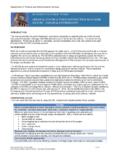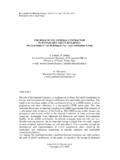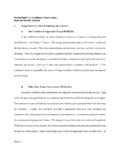Transcription of Construction Rules and Regulations - TI - Landlord Hires ...
1 G:\Sturm Realty Group\(3) Property Management\Property Management\Label' \ Construction Rules and Regulations - TI - Landlord Hires Tenant Improvements Landlord Hires contractor Construction Rules and Regulations 1. Protection: During the initial moving in of equipment and materials, Floor and during those times when substantial amounts of materials are received, all common area carpet and corridors between the freight elevator and the building-out area must be protected with visquine, masonite or other like material approved by building management. Protection to corridor areas must include corner boards, elevator threshold covers and doorway protection, in some manner. 2. Permits and Inspections: It will be the Tenant/ contractor s sole responsibility to provide all necessary permits by the City and County prior to the commencement of work.
2 Permits, as required, will be posted in a visible location. It will also be the responsibility of the Tenant/ contractor to ensure that all work is inspected and signed off. 3. Demolition: The following Rules and Regulations apply: a) The building s trash container is not to be utilized for Construction debris. b) Prior approval of vendor and location approval is necessary for the placement of contractor s dumpster. c) In the event any supply ducts are opened up or removed anywhere on the floor, they must be immediately capped so the system can maintain static pressure. d) Thermostats in the Construction area, in many situations, are usually servicing zones in occupied suites and corridors. Therefore, they must not be turned off, removed, capped or remounted in a different location than the drawing identifies.
3 E) All pneumatic lines are to be capped immediately should changes be required. Replacements or additions should be done while lines are tied into the thermostat. f) All doors, frames, lights, side lights, plumbing fixtures, under counter appliances, cabinetry, carpet pieces or any other material permanently fixed to the premises are the property of the building. Arrangements must be made to transport these items to the building s designated storage area or have to be removed from the property at contractor s expense at the direction of Building Management. G:\Sturm Realty Group\(3) Property Management\Property Management\Label' \ Construction Rules and Regulations - TI - Landlord Hires g) All trash and unused materials should be removed from the building by the contractor as the work progresses and at its completion in accordance with Landlord s requirements.
4 Trash must be transported in a Rubbermaid-type container so as to not damage walls, floors, etc. Absolutely no Construction debris will be permitted to be stored inside or outside of the immediate Construction area. Special arrangements for trash removal may be required and must be arranged through the management office. 4. Job Site Cleanliness: All work areas must be left broom clean each evening, including those areas associated with material moving (including loading dock and corridors, etc.). Contractors are to supply their own cleaning equipment and supplies for Construction cleanup and are specifically prohibited from utilizing Building janitorial equipment. contractor is not permitted to obstruct common areas on any floor plate that may be occupied by other tenants.
5 5. contractor s Equipment: contractor and their subcontractors are responsible for the safekeeping of their own equipment, supplies and tools. Neither the Landlord , Tenant nor Management Office will be responsible for any missing items. No tools, supplies, etc. are to be placed outside of the Construction area. 6. Common Area Interface: Doors into common area corridors are to remain closed at all times. If an entry door has yet to be installed, a temporary door must be installed to stop dust from entering the public areas. No doors are to be propped open into the common area corridors and must include a mat, which will be placed to wipe dust from shoes before re-entering the common area. contractor is required to install mastic floor protection with an adhesive step surface or like materials / products to protect finished floor surfaces immediately outside of the Construction area.
6 Any dust, paint or other debris tracked into corridors must be cleaned up immediately by the contractor and any damage to corridors, elevators or other parts of the building must be repaired at the contractor s expense. Should the contractor , after notification, not correct the situation, it shall be corrected by Building Management at the contractor s sole expense. 7. Radios: No radios, tape players, or like, may be operated within the Premises at any time. 8. Ceiling Work: Electrical, plumbing, cabling, or other services which require access to the ceiling must be performed professionally, neatly and as quickly as possible. If access to a tenant space is required, access to a tenant space is required, access must be requested to Building Management and approved a minimum of 48 hours in advance.
7 If the G:\Sturm Realty Group\(3) Property Management\Property Management\Label' \ Construction Rules and Regulations - TI - Landlord Hires affected tenant requests security escort, that shall be at the cost of contractor . Fingerprints, dirt, Construction debris, etc., are expected to be removed immediately with the area vacuumed and dusted if necessary. Removal and replacement of ceiling tiles must be performed with clean gloves to minimize dirt and finger prints. 9. Use of Hazardous Substances: contractor shall provide management a list describing the material, its use, along with Material Safety and Data Sheets any time hazardous substances are used on the facility. This list is to be turned in to the property manager, prior to the utilization of hazardous substances in conjunction with Construction .
8 No propane, kerosene, gasoline or other similar flammable gas or liquid used in Construction is permitted on the Premises except when in use and must never be left unattended. Such equipment is to be removed from the Premises when not in use during the off hours or weekends. Absolutely no storage of rags, containers, brushes, etc. are permitted on-site unless planned for use that day. 10. Fumes: No painting, spraying, staining or other work which involves noxious fumes is permitted during common working hours of the Building (Monday through Friday 7:00 am to 6:00 pm). Arrangements for special ventilation should be made with the management office. The contractor will be required to pay the cost of all after hours service. 11. Smoke Detection System Requirement: When spraying paint, sanding or performing any other work that may involve an appreciable amount of dust, the Building s Engineering and Management must be notified 24 hours in advance so that the fire alarm/smoke detection system and the ventilation system may be taken off-line and cleaned at contractor s expense.
9 The contractor will also be required to pay the costs associated with taking the system off line after normal business hours and weekends. 12. Fire and Life Safety Systems: contractor and all associated subcontractors must ensure with the building engineer and management that the fire system is taken off-line, if necessary, before the commencement of work. The cost of all false alarms will be charged back to the contractor . Repeat offenders will be removed from the approved contractor list and no longer be permitted access to the Premises. Fire equipment should be considered and reviewed with the Building Management and Engineering before starting the work (including smoke detectors, flow switches and sprinkler lines, pull stations, fire dampers, return air duct detectors, etc.)
10 Engineering and/or the Manager can be contacted through the lobby desk. All testing of audible alarms must be done before or after normal business hours and coordinated with Building Management and Engineering. A contract between the General contractor and the Building s designated electrical contractor is required G:\Sturm Realty Group\(3) Property Management\Property Management\Label' \ Construction Rules and Regulations - TI - Landlord Hires for final connections to the main fire annunciator equipment in the lobby fire command center. 13. Alarm System Modification: .Any change to the existing Building fire alarm system, including but not limited to relocation of horns, speakers, magnetic hold opens, card access system interface, etc., must be approved by Building Management and coordinated with Building Engineering.





